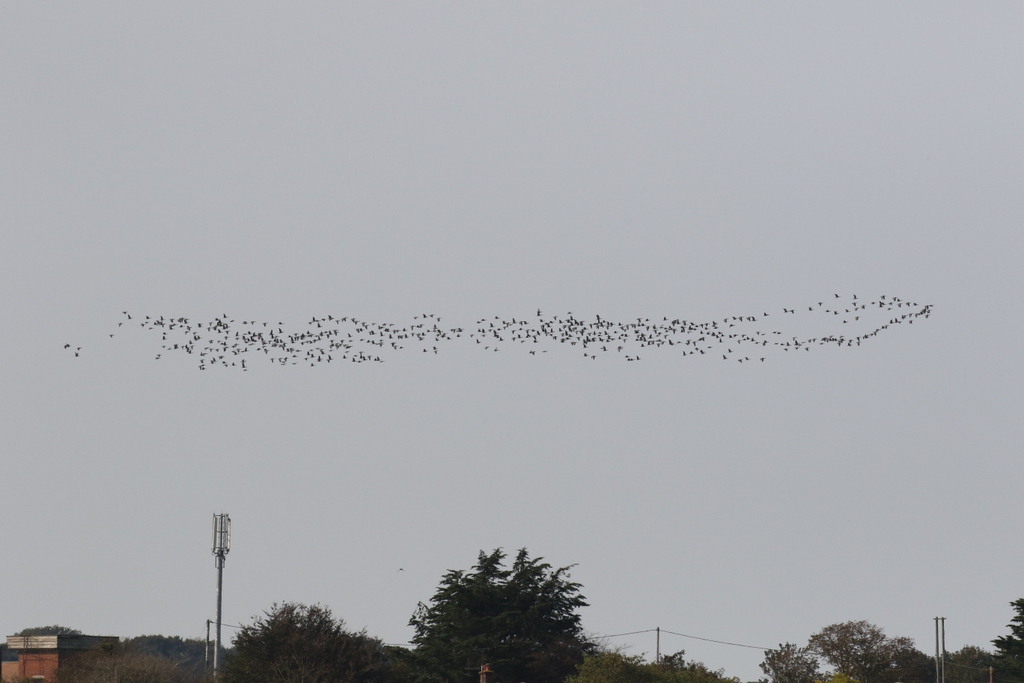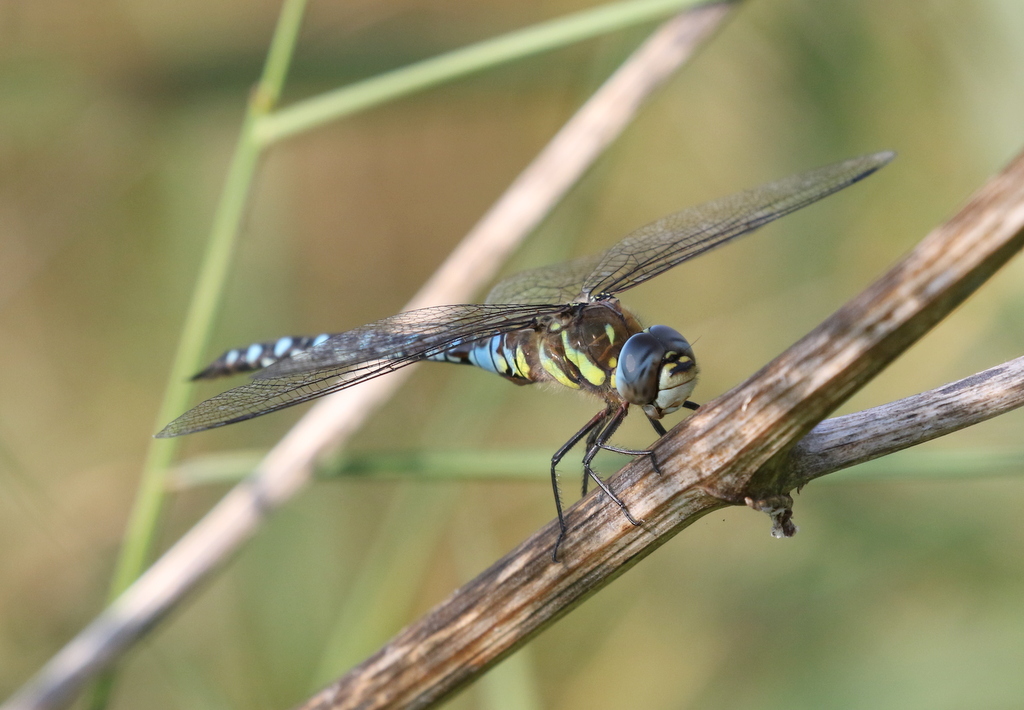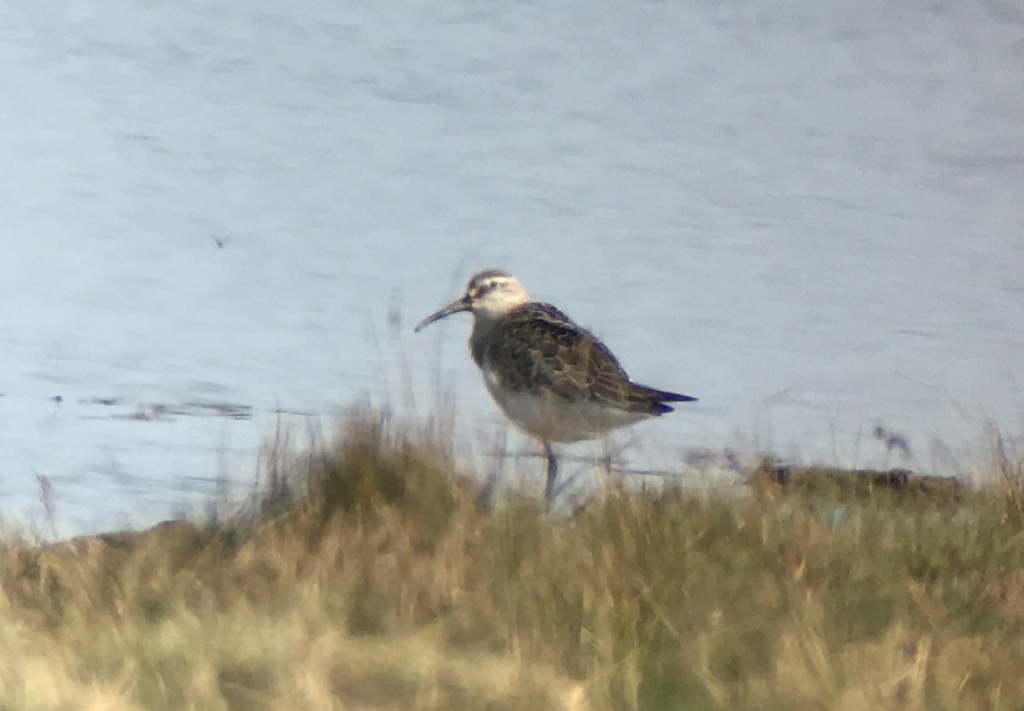Day 1 of a two day Early Autumn Private Tour in North Norfolk today. It may be autumn, but it felt more like summer, with wall-to-wall blue skies and thankfully a nice light southerly breeze on the coast which kept the temperatures from getting too hot. Not great conditions for migrants perhaps, but fantastic weather to be out birding in Norfolk.
Our first destination for the morning was Wells. As we got out of the minibus and removed our face masks, we could hear a Greenshank calling, presumably flying over. A Common Buzzard was perched on a post in front of us, in the morning sunshine. A small flock of Meadow Pipits flew over calling.
We heard geese calling, the low honking of Greylags, and turned to see a large flock several hundred strong come up from the fields the other side of the road. They flew in over us, calling noisily, and circled round to land over the back of one of the pools.

The pools are rapidly drying out now, but the Greylags had landed in the deeper water at the back. In amongst them, we could see lots of Wigeon and Teal, all the drakes now in their drab eclipse plumage. There were several Ruff around the muddy edges and three Dunlin on the front of one of the islands. A flock of Black-tailed Godwit in the deeper water was almost lost in with all the geese.
On the other side of the track, the pools have gone with just some damp mud in the middle. There were no waders on here now, but a small group of Egyptian Geese were feeding in the grass and a Grey Heron and Little Egret on the edge of the deeper channel at the back.
As we walked down the track, a Common Whitethroat flicked out of the bushes. At the far end, we could hear a Kingfisher calling and after a couple of minutes it came up out of a ditch and flew across the track in front of us, in a flash of electric blue. Another flock of Meadow Pipits flew overhead calling. They have been on the move this week, so these were possibly migrants which had stopped here overnight.
There were lots of people out in the sunshine, and a dog running around between the bushes. Perhaps not surprising that there were few birds in here at first, until we got round to the seawall. Here the bushes held lots of finches – Goldfinches, Linnets and Greenfinches – plus several Reed Buntings, Blackcaps and more Common Whitethroats.
As we walked along the seawall, a Chaffinch was feeding on the ground and a Wall butterfly flitted ahead of us. When it finally landed, we edged forward to take some photos, before it was flushed by a couple of joggers coming the other way. This was the first of several we saw here today.

Continuing down to the corner, we stopped to look at the western pool. A Green Sandpiper was feeding in the shallow water tucked in the corner and a single Common Snipe was asleep on the bank at the back.
Looking behind us, some people were walking towards us along the bank, and a Wheatear was on the path ahead of them. Thankfully, it just flew down to a post on the edge of the saltmarsh below the bank so we could get a good look at it. Then it dropped down to the ground below to catch something, before flying up to another post further back, flashing its white rump.

A flock of geese flew up from the fields off to the south. They were a long way off, but they looked small, dark. Through the scope, we could see they were Pink-footed Geese and as they got a bit closer, we could just hear their yelping calls, much higher pitched than the Greylags we had seen earlier.
Another couple of larger flocks of Pink-footed Geese came up behind them – they clearly weren’t going far because they didn’t form into skeins and remained in untidy groups. We watched them as they flew over Wells town and started to whiffle down towards Quarles Marsh beyond. There were probably up to 1,000 Pink-footed Geese in total, already returned from Iceland. Here for the winter, a reminder that summer is over, even if it didn’t feel like it today!

Looking out across the saltmarsh, we could see a couple of white shapes, one larger than the other, a Spoonbill and a Little Egret. The Spoonbill disappeared down into a channel to feed, out of view. We could see its head a couple of times before it came back up out and into view. Almost immediately it took off. It flew in, long neck and bill stretched out in front, towards the pools, but perhaps seeing no other Spoonbills there it turned and disappeared off to the east.
Scanning the rest of the saltmarsh, there were lots more Little Egrets, several Curlew and Redshank. A smart Grey Plover still sporting its summer black face and belly, was in one of the muddy channels. It was time for coffee, so we made our way down off the seawall and back round through the bushes. A small party of Swallows came over, migrants on their way west.
After a break for coffee, we continued east along the coast road to Cley. After a quick stop at the Visitor Centre to use the facilities, we drove round to the beach car park. It was very busy at the beach today – even the overflow was filling up fast. We walked out over the shingle and off to the east, away from the crowds.
Looking out to sea, it was very calm and not surprisingly there didn’t appear to be many birds offshore. Lots of gulls were following a fishing boat. It was warm now and there were not many birds in the vegetation on the beach either. We were hoping to find a Whinchat along the edge of the Eye Field, but the best we could muster were several Pied Wagtails by the small pool.
Over the ridge in the Eye Field, we stopped to scan the reserve. It was a lovely view, and very pleasant with the light breeze in our faces. North Scrape is almost dry now, but we did pick up a Hobby out over the reedbed beyond, hawking back and forth low over the reeds for insects. On the walk back, a Wheatear had appeared on the shingle by the pill box with the Pied Wagtails now.

A very distant Gannet was now offshore and we picked up a large flock of waders flying past. We could see the larger ones were Knot and presumably the smaller ones were Dunlin, but they were a long way out at first. The Knot continued on west, but the smaller waders started to zigzag inshore. They were indeed Dunlin but as they turned, we caught a flash of a couple of white rumps – it looked like there were a couple of Curlew Sandpipers in with them. But rather than continue coming in, they now carried on west.
We stopped for lunch in the car park, and afterwards headed round to Walsey Hills. There was no space and we had several cars behind us, so we drove on, turned round and came back on the right side of the round. Thankfully there were now a couple of parking spaces.
Three juvenile Little Grebes were on Snipes Marsh, one of which looked very ungainly as it climbed out onto the mud. We set off up the East Bank, where two adult Little Grebes kept surfacing in the thick weed on Don’s Pool. There were plenty of dragonflies enjoying the sunshine too, several Common Darters along path and a very obliging Migrant Hawker which landed in the vegetation beside us so we could get a closer look at it.

Scanning the mud of the Serpentine, we quickly picked out the juvenile Curlew Sandpiper in with several Redshanks. It was busy preening, and as it opened its wings we could see its white rump, as well as its long, downcurved bill.

There was a single Common Snipe in the far corner too and a Green Sandpiper which was feeding along the near edge of the water and hard to see behind the low bank. A large flock of Curlew was sleeping in the grass beyond. A male Marsh Harrier was quartering over the reeds further back still.
Continuing on to Arnold’s Marsh, there were just two Sandwich Terns out here today. More Curlew and Common Redshanks were scattered around. Several Shelducks were out here too – mostly juveniles, as the majority of the adults have gone off to moult in huge flocks on favoured estuaries, many to the Continent and the Waddensee. One or two adults are left behind to look after the young, and we picked out one here today, noticeably brighter and redder-billed than the juveniles.
There were obviously a couple of Gannets feeding just offshore here. We caught sight of a dark juvenile as it plunge-dived, then watched a sub-adult circle over the beach, before flying off east along the shingle ridge. Then it was back to the minibus and we drove back west to Stiffkey Fen to finish the afternoon.
A Chiffchaff was singing in the trees as we walked down along the permissive path, and several Blackcaps were in the trees down by the river. When we got to a spot where we could just about see through a gap in the vegetation to the Fen beyond, we could see a big gathering of large white shapes on one of the islands.
We counted at least 45 Spoonbills today – they were hard to count as some were sat down or hidden behind the others – and mixed in with lots of Little Egrets too. Viewing was rather restricted from here too. The Spoonbills were mostly asleep – as they normally are when they roost here over high tide. It won’t be long before they are heading off, so it is good to see such a large number still here today.

Continuing on, as we got up onto the seawall, a Greenshank flew in along the harbour channel below and over the bank towards the Fen. We could just see a few Little Egrets from here, and a single Spoonbill, as they were mostly hidden behind the reeds from here today. As the Fen has started to dry out, they have moved where they like to roost.
Beyond the Little Egrets, we picked up a Green Sandpiper in front of the reeds at the back with a couple of Ruff. From further along, we could see another Green Sandpiper in the corner over by the hide, along with seven Greenshanks and lots of Redshanks. A Knot was half hidden in amongst all the Black-headed Gulls on the shore of the island in the middle.
There were lots of moulting ducks, mainly Mallard, Wigeon and Teal, but we found several Pintail asleep in with them. The drakes are all in drab eclipse plumage at the moment, but we did find one awake and swimming in the water, which showed off its still pointed tail as it upended.
Further along still, we looked back into the front corner. Five more Greenshanks were tucked in here and a single Gadwall was on the mud nearby. A Water Rail squealed from down in the reeds below us and we heard two or three Cetti’s Warblers singing while we stopped to scan the Fen.
Looking out across the harbour, the tide was coming in quickly now. A Marsh Harrier flew across over the saltmarsh and disappeared up the harbour. Scanning the edges of the pit, we could see small groups of waders on the remaining shingle islands, more Knot, a few Turnstones and Oystercatchers. There was a lot of disturbance out in the harbour today, lots of people walking on the shore, lots of boats – a large flock of Oystercatchers and Knot flew up from where they had been trying to roost across and disappeared off towards Warham.
It was lovely standing here in the sunshine, looking out across the harbour towards the Point, quite a view. A Kingfisher shot past over the channel and disappeared off east. It was time to head back.
















